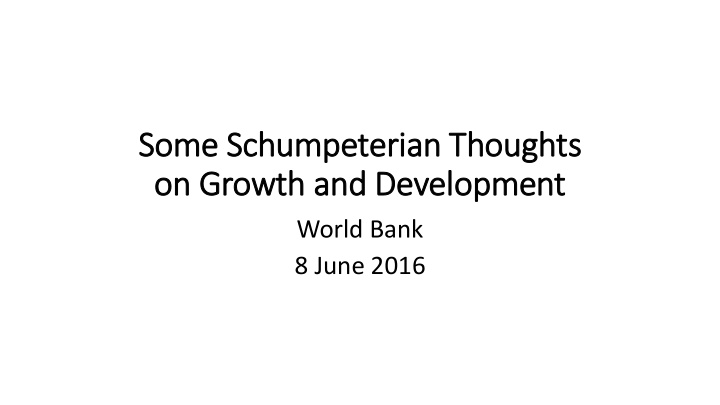



Some Schum humpeter erian Th Though ghts on on Gro rowth and nd Developm opmen ent World Bank 8 June 2016
Peter Howitt
Joseph Schumpeter
Sch Schumpeterian g growth theor ory • Long-run growth driven by innovations • Innovations result from entrepreneurial activities motivated by prospect of innovation rents • Creative destruction: new innovations displace old technologies
Outlin line • Introduction • Growth enigmas • Growth meets development
Growth eni enigmas • Competition and growth • The debate on secular stagnation • Innovation, inequality, and social mobility • Firm dynamics
Competition and growth: theoretical prediction
Competition and growth: empirical relationship
Richard Blundell
Competition, growth and distance to frontier
Competition and growth: the inverted-U relationship
Growth eni enigmas • Competition and growth • The debate on secular stagnation • Innovation, inequality, and social mobility • Firm dynamics
Secular stagnation? • Gordon and the fruit-bearing tree approach
Secular stagnation? • Dale Jorgenson • Missing Growth
Missing G Growth from om C Creative D Destruct ction on (Agh ghion on, , Ber Bergeaud eaud, , Bop oppart, , Kl Klenow, Li; 2 2016) 016) • ABBKL argue that innovation involving creative destruction is not properly taken into account by current measures of TFP growth • Typically, whenever old products in the PPI are replaced by new products, the statistical office (BLS) uses the price changes of surviving (incumbent) products to infer the overall inflation rate • Using the Schumpeterian growth paradigm, we provide explicit expression for economy-wide missing growth from creative destruction
Missing G Growth from om C Creative D Destruct ction on (Agh ghion on, , Ber Bergeaud eaud, , Bop oppart, , Kl Klenow, Li; 2 2016) 016) • We use two different methods to calibrate missing growth from creative destruction: • In the first exercise, we use micro data from the Longitudinal Business Database (US Census) on the employment/payroll shares of entrants, exiters, and continuers in all non-farm business sectors • In the second exercise, we use data on the flow and quality of patents (exploiting information on patent citations) to estimate the arrival rates and stepsizes of the various kinds of innovation • The two exercises yield missing growth estimates of comparable magnitude, from 0.4 to 1 percentage point on average per year.
Growth eni enigmas • Competition and growth • The debate on secular stagnation • Innovation, inequality, and social mobility • Firm dynamics
Income shares at the very top over last 100 years: US top 1% increases from 9% in 1978 to 22% in 2012 30 25 US Top 1% 20 Percentile Share 15 US Top 0.1% 10 5 0 1918 1920 1922 1924 1926 1928 1930 1932 1934 1936 1938 1940 1942 1944 1946 1948 1950 1952 1954 1956 1958 1960 1962 1964 1966 1968 1970 1972 1974 1976 1978 1980 1982 1984 1986 1988 1990 1992 1994 1996 1998 2000 2002 2004 2006 2008 2010 2012 U.S. Top 1% U.S. Top 0.1% Source : Atkinson, Piketty & Saez; High Income Database
Main i idea ea • Innovation is a source of top income inequality which differs from other sources (entry barriers,..) • *Steve Jobs* versus *Carlos Slim*
Why innovation on d differs from om ot other sou ource ces of of t top op 1% i incr crease? • Generates growth (we know) • But in addition: • Innovation does not seem to increase broad inequality • Innovation positively correlated with social mobility (creative destruction)
By contrast, lobbying… • Increases top income inequality • Increases inequality at large • Reduces social mobility • Does not enhance growth
Growth eni enigmas • Competition and growth • The debate on secular stagnation • Innovation, inequality, and social mobility • Firm dynamics
Firm d dyn ynamic ics • The empirical literature has documented various stylized facts on firm size distribution and firm dynamics using micro firm-level data. • the firm size distribution is highly skewed; • firm size and firm age are highly correlated; • small firms exit more frequently, but the ones that survive tend to grow faster than the average growth rate.
Firm S Size D Distribution w with M Multiproduct Firms
Outlin line • Introduction • Growth enigmas • Growth meets development
Gr Growth m meet d developmen ent • Appropriate growth policy and the middle income trap • Growth, development and firm dynamics
Competition, growth and distance to frontier
En Enhanci cing g prod oduct ctivi vity g growth i in advance ced cou ountries - Liberalization of product market - Investment in higher education - Liberalization of labor market - Equity financing
En Enhanci cing g prod oduct ctivi vity g growth i in emergi ging m g market econ onom omies • Foster technology transfers (Keller,…) • Reallocate factors (Hsieh and Klenow,…) • Improve management practices (Bloom and Van Reenen,…)
Gr Growth m meet d developmen ent • Appropriate growth policy and the middle income trap • Growth, development and firm dynamics
Gr Growth, d devel elop opment, a and firm d dynam amics • Hsieh and Klenow • Akcigit, Alp and Peters
Link between the age and the size of firms
Distribution of firms productivity
Conclusion • Schumpeterian growth theory is both, a new theory and also a new way to do growth theory, through continuous dialogue with micro- econometricians and micro-data • The purpose is both, to better understand the growth process and also to rethink growth policy • Addressing growth enigmas is useful, not only to satisfy our scientific curiosity, but also for society
Recommend
More recommend